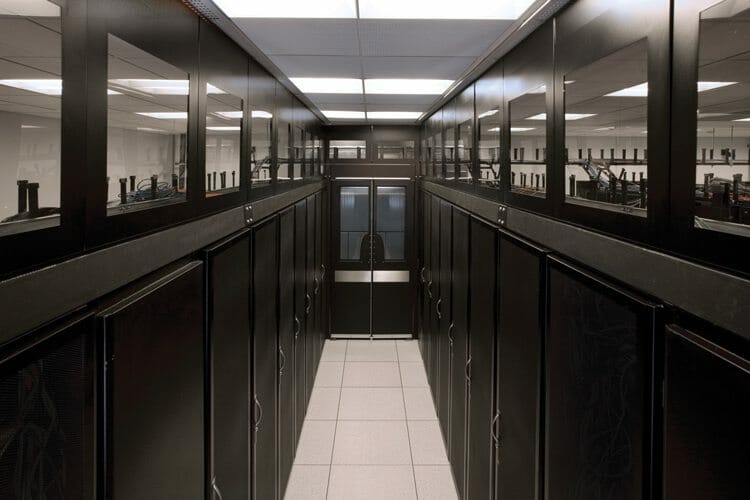Hot Aisle Containment vs. Cold Aisle Containment: Which is Better for the Data Center?17 min read

Containment has gone mainstream in the past few years in the data center industry, which has led to widespread implementation and adoption by many sites. In fact, according to a recent survey by the Uptime Institute, 80% of sites have implemented either hot or cold aisle containment. While the survey represented mostly larger facilities, many medium and small facilities have either implemented or are considering some form of containment. This high rate of adoption has left a lot of people asking the same question: Is it better to contain the hot aisle or the cold aisle?
A 2011 third party empirical study was conducted by Intel and T-Systems in a data center test lab in Germany. They published their results in a paper titled, “Data Center 2020: Hot-Aisle and Cold-Aisle Containment Efficiencies Reveal No Significant Differences.” The title pretty much says it all. So we look to factors other than the economics of efficiency to evaluate the relative merits of the two approaches to containment.
→ One thing to keep in mind, the goal of both hot and cold aisle containment is the same: to improve IT equipment intake air temperatures and create an environment where changes can be made to reduce operating cost and increase cooling capacity.
So back to the question, which is better? Assuming a computer room is configured in such a way that either is an option, hot aisle containment may be seen as the better option because it has some thermal efficiency and ride-through advantages. However, because every computer room is unique, there is no one definitive solution. For this reason, it is important to understand all the differences between hot aisle containment and cold aisle containment so you can make a decision appropriate to a particular architectural environment and business strategy.
For clarification, cold aisle containment involves doors on the ends of the cold aisles and some form of partitions or roof over the cold aisle. Hot aisle containment includes doors on the ends of the hot aisle and a configuration of baffles and duct work from the hot aisle to the returns of the cooling units. Drop ceiling plenums are often used as the means to duct the return air back to the cooling units. Both strategies have their benefits as well as their challenges:
Cold Aisle Containment Benefits:
- Easier to implement; does not require additional architecture to contain exhaust air and return it to the cooling units (drop ceiling, air plenum etc.).
- Only requires doors at ends and cap at top.
- Generally less expensive.
- Cold aisle containment is typically going to be easier to retrofit in an existing data center, particularly when there are overhead obstructions to circumnavigate, such as power and network distribution, ducts, lighting.
- Cold aisle containment doesn’t absolutely need to be on a raised floor, but it typically is because of challenges associated with delivering supply air to the contained space(s).
- Enables more surface area for “cold sinks” (with or without a raised floor) ride through in the event of power failure and engine generators not starting.
Cold Aisle Containment Challenges:
- In cold aisle containment, the overall data center becomes the hot aisle and that space could be dramatically hot if the theoretical advantages of containment are fully pursued, i.e., higher supply temperatures resulting in possibly extreme exhaust temperatures.
- There may not be any space with a suitable temperature profile for equipment that for whatever reason is not compatible with living in the containment arrangement. This could mean lowering the supply temperature and losing some of those economic benefits to providing a suitable environment for some of these non-contained electronics.
- Increases mixing of return air and lowers delta T.
- Conditioned air leaking from the raised floor and openings under equipment such as PDUs enters the exhaust air paths returning to cooling units. This reduces the efficiency of the system.
- Full cold aisle containment creates what the NFPA codes call a “separate volume”, so there needs to be fire suppression for the overall data center space and then either additional fire suppression for the contained cold aisle or the containment must be connected to the smoke detection system and remove itself as an obstruction on a smoke alarm.
Hot Aisle Containment Benefits:
- Open area of room is a cold environment.
- Leakage from raised floor openings in the larger area of the room goes into the cold space.
- Generally more effective.
- Hot aisle containment will be more forgiving for network racks and stand-alone equipment such as storage cabinets that might have to live outside the containment architecture, i.e., they will live in the lower temperature area of the computer room.
- Hot aisle containment can perform well in a slab environment by merely flooding the data center with an adequate volume of supply air and containing the exhaust air.
- Hot aisle containment, by virtue of the containment structures typically abutting the ceiling where fire suppression is installed, is not creating separate volumes, but merely creating obstructions which need to meet clearance requirements from sprinkler heads. With a well-designed space, it is conceivable that a standard grid fire suppression system could be installed around a hot aisle containment array of barriers and meet code.
Hot Aisle Containment Challenges:
- Requires a contained path for air to flow from the hot aisle all the way to cooling units. Often a drop ceiling is used as return air plenum.
- Generally more expensive.
- Higher temperatures in the hot aisle create uncomfortable conditions for technicians working on IT gear. Note that some server manufacturers are developing and supplying front-serviceable servers, which means that the hot aisle, whether contained or not, would hardly ever need to be entered.
Bypass Airflow Considerations
Aside from the benefits and challenges of each strategy, the effects on bypass airflow should also be taken into consideration. Bypass airflow occurs when the total flow rate of air through all cooling units exceeds the flow rate of air through IT equipment. Implementation of both hot and cold aisle containment does not reduce the volumetric flow rate of bypass airflow in a computer room.
When cold aisle containment is implemented, pressure management of the cold aisle is necessary to minimize the impact of driving “bypass air” directly through the servers. With hot aisle containment, the excess volume of conditioned air delivered to the space is typically not pushed through IT equipment but enters the exhaust air flow path before returning to cooling units.
Both containment strategies, if implemented well, create an environment where cooling unit fan speeds can be reduced or cooling units turned off to reduce bypass airflow flow rates. These adjustments are necessary to realize the benefits of reducing fan energy and increasing return temperatures, which increase the sensible cooling capacity of cooling coils and partial economization hours of any free cooling systems.
Conclusion
If a computer room was configured in such a way that either hot aisle containment or cold aisle containment could be implemented, with all other factors aside, hot aisle containment would be the better option. However, the fact of the matter is, each and every computer room is unique. Whether it be hot or cold aisle containment, each computer room may reveal conditions that will make one strategy more suitable over the other. The best thing to do is evaluate your site, evaluate the pros and cons of each strategy, take into consideration bypass airflow, and use this information to determine which strategy is right for you and your facility.
The industry's first and only tool-less containment solution!
AisleLok® is the industry’s first modular containment solution,
proven to provide the core benefits of containment with greater flexibility and value.
The industry's first and only tool-less containment solution!
AisleLok® is the industry’s first modular containment solution,
proven to provide the core benefits of containment with greater flexibility and value.

1 Comment
Trackbacks/Pingbacks
- Electronics Racks and the Future of Mankind with Technology - Web Commerce - […] that are dealing with an excessive amount of information, networks, or computing equipment. Electronics racks usually must be accompanied…
- Hot Aisle Containment Can Reduce the Risk of Equipment Failure - - […] both needs and minimize the risk of equipment failure. Benefits of Hot Aisle Containment Options. Hot aisle containment options…
- Necessary and Effective IT Storage Tips - How I Met Your Motherboard - […] One of the additional benefits of using IT racks is that the IT professional can install data racks that…
- Are You Conserving Energy Even As You Use It? Filling Your Data Center With Eco-Friendly Server Racks - Deperimeterize - […] Hot aisle containment solutions, such as an up-to-date server cabinet, will do wonders for saving you money. The first…
- 5 Tips to Keep Your Equipment Cool During the Summer - Script Installation - […] is an important part of any cold aisle containment system. This is also a cost effective way to go.…
- Is Cold or Hot Aisle Containment Better For Your Data Center? - […] take a look at the pros and cons of each (detailed more at Upsite Technologies) before we make our […]
Submit a Comment
Airflow Management Awareness Month 2020
We’re hosting four free educational webinars throughout the month of June. Don’t miss them!
I am agree with the point that there is not perfecr answer which containment is better than the other, it is all depned on the size and condition of the building envornment. fiance budget for data center build out,
I personally more prepfer cold containment as it is more flexible & easier to imply, lower risk on over temperature, more comfortable for technical staff servicing the IT equipment. As far as hot containment concerned, I always have concerned that in case there is power failurer and caused cooling system shut down the temperature at the hot contaiment would increase reapidly in short period of time, ventilation system, chilled water storage or ice ball solution are required as back up system to remove build up heat dispacement from IT equipment and maintain the data center preset temeperature!